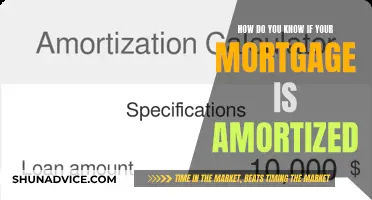
If you're facing financial difficulties and are looking for mortgage relief solutions, it's important to know who owns your loan. Many mortgages are owned by Fannie Mae and Freddie Mac, and both offer online tools to help you find out if they own your mortgage. To use these tools, you'll need to provide some personal information, such as your name, part of your social security number, and your property address. Knowing if Fannie Mae owns your mortgage is crucial, as it can determine your eligibility for mortgage relief options like forbearance plans or loan modifications under the CARES Act.
| Characteristics | Values |
|---|---|
| How to find out if Fannie Mae owns your mortgage | Use the online mortgage lookup tool on the Fannie Mae website |
| What to do if Fannie Mae owns your mortgage | Contact your loan servicer and let them know your loan is owned by Fannie Mae |
| What to do if you are facing financial uncertainty and have a Fannie Mae-owned loan | You may qualify for mortgage relief solutions like a forbearance plan or loan modification |
| What to do if you are unable to find the owner of your loan | Look up your mortgage servicer by searching the Mortgage Electronic Registration Systems (MERS) website or send a written request to your mortgage servicer |
| What to do if you are unsure who your mortgage servicer is | Find the number for your mortgage servicer on your monthly mortgage statement or coupon book |
What You'll Learn

Fannie Mae's Loan Lookup Tool
If you're facing financial uncertainty and have a Fannie Mae-owned loan, you may qualify for mortgage relief solutions like a forbearance plan or loan modification. To find out if your mortgage is owned by Fannie Mae, you can use their online Loan Lookup Tool. This tool will ask for your first and last name, address, and the last four digits of your Social Security Number.
It is important to fill in every field carefully as a mistake or typo can result in incorrect results. You will receive one of two status messages: either no match or a match. If it's the latter, you may be eligible for help, and it will list the mortgage company that owns your loan, the loan closing date, and questions about delinquency. If you receive a "no match" result, try re-entering your information or, if there is a co-borrower, enter their information. Be sure not to enter symbols, special characters, or generational titles in the input fields.
If you own a condo or townhome and still receive a "no match" result, try a new search with your unit number in the address field, leaving the unit field blank. You can also see if Freddie Mac owns your loan using their online tool. Knowing who owns your loan can be helpful in determining if you're eligible for a particular loan modification or foreclosure prevention options.
Strategies to Exit Your Mortgage Early: A Guide
You may want to see also

Online mortgage look-up tools
If you want to find out whether your mortgage is owned by Fannie Mae, there are several online tools you can use. Firstly, Fannie Mae has its own loan lookup tool on its website. Here, you can fill out a short form with your name, the last four digits of your social security number, and your property address. They will then notify you immediately if they own your loan. It is important to fill in every field carefully, as a mistake or typo can lead to incorrect results.
Another option is to look up your mortgage servicer by searching the Mortgage Electronic Registration Systems (MERS) website. This will provide you with the name, address, and telephone number of the owner of your loan. Additionally, you can send a written request, such as a Qualified Written Request or a Request for Information, to your mortgage servicer. They are obligated to provide you with the information you need to know about the owner of your loan.
If you are facing financial uncertainty and have a Fannie Mae-owned loan, you may qualify for mortgage relief solutions like a forbearance plan or loan modification.
Strategies for Affording a Mortgage: Financial Planning Tips
You may want to see also

What to do if Fannie Mae owns your mortgage
If you want to find out if Fannie Mae owns your mortgage, you can use the Fannie Mae Loan Lookup Tool on their website. You will need to provide your name, the last four digits of your social security number, and your property address. You will then be notified immediately if they own your loan or not.
If Fannie Mae does own your mortgage, you don't need to take any action. Your mortgage servicer—the company that you send your monthly payments to—and your loan terms will remain the same. You should continue to send all mortgage payments to your servicer. However, if you are facing financial uncertainty, you may qualify for mortgage relief solutions like a forbearance plan or loan modification. You might also be eligible for RefiNow, an option that can lower your interest rate and reduce monthly payments.
If you need to contact Fannie Mae, you can call 800-2FANNIE (800-232-6643) or visit their website for more information. It is worth noting that Fannie Mae does not service mortgage loans, so you should contact your mortgage servicer directly if you have any questions about your loan.
Is There a Mortgage on That Property?
You may want to see also

Understanding your loan purchase letter
If you're facing financial uncertainty and are looking for mortgage relief solutions, it's important to know who owns your loan. Many mortgages are owned by Fannie Mae, Freddie Mac, FHA, USDA, or VA. Knowing if your mortgage is owned by Fannie Mae can help you determine if you're eligible for specific loan modifications or foreclosure prevention options.
Fannie Mae offers a loan lookup tool on its website, where you can fill out a short form with your name, the last four digits of your social security number, and your property address. They will then notify you immediately if they own your loan. If they do, you may be eligible for mortgage relief solutions like forbearance plans, loan modifications, or RefiNow™, which can lower your interest rate and reduce monthly payments.
If you receive a loan purchase letter from Fannie Mae, it means they have purchased your loan from your lender. This letter is for informational purposes only, and no action is required on your part. Your loan terms, including your mortgage loan, deed of trust, or note, remain the same, and you should continue sending all payments to your mortgage servicer, not Fannie Mae. The letter will also identify your mortgage servicer, who you can contact directly if you have any questions about your mortgage loan.
It's important to note that Fannie Mae is not a mortgage servicer and does not service mortgage loans. Your mortgage servicer is the company that collects your monthly loan payments, and their contact information can be found in the welcome packet you received or on your monthly mortgage statement. If you need assistance with your mortgage, your servicer should be your first point of contact.
Becoming a Licensed Mortgage Originator in Texas
You may want to see also

Fannie Mae's resources for homeowners
Fannie Mae offers a range of resources to help homeowners, especially first-time buyers, navigate the complexities of homeownership and make informed decisions.
One of their key tools is HomeView, a comprehensive online course designed to educate prospective homeowners about the homebuying process. HomeView covers various topics, including building and managing credit, navigating the steps to homeownership, and understanding mortgage products. It also provides valuable tips on homeownership responsibilities, such as paying your mortgage, planning for expenses, and maintaining the value of your home. The course is available in English and Spanish and aligns with National Industry Standards for pre-purchase homeownership education.
Fannie Mae also provides a Loan Lookup Tool to help homeowners facing financial uncertainty. This tool allows homeowners to check if they have a Fannie Mae-owned loan and explore options for mortgage relief, such as forbearance plans, loan modifications, or refinancing solutions like RefiNow™, which can lower interest rates and reduce monthly payments.
Additionally, Fannie Mae has introduced a new online tool to help associations determine their "Fannie Mae" eligibility status. This tool enhances transparency and efficiency in the lending process, benefiting all participants and promoting sustainable homeownership.
Fannie Mae also offers resources to help homeowners understand the technical terms and acronyms on their monthly mortgage statements, as well as tools to assess housing needs and navigate the ins and outs of owning a home, including refinancing and disaster preparedness.
For those facing financial difficulties, Fannie Mae encourages homeowners to work with their mortgage lenders to explore other financing options and assistance programs. They also caution homeowners to be vigilant against scammers targeting homeowners in crisis and to carefully review any offers that seem too good to be true.
Transitioning from Real Estate to Mortgage Brokering
You may want to see also
Frequently asked questions
Fannie Mae offers a mortgage lookup tool on their website. You will need to fill out a short form with your name, the last four digits of your social security number, and your property address. You will then be notified immediately if they own your loan.
You should contact your loan servicer (the company you make your mortgage payments to each month). Let them know that your loan is owned by Fannie Mae and that you need assistance.
Your loan servicer is the company that collects your monthly loan payments. Their contact information should be listed on the welcome packet they sent you. It should also be on the loan purchase letter you received.
You can find the number for your mortgage servicer on your monthly mortgage statement or coupon book. You can also look up your mortgage servicer by searching the Mortgage Electronic Registration Systems (MERS) website.
If your mortgage is owned by Fannie Mae, you may qualify for mortgage relief solutions like a forbearance plan or loan modification if you are facing financial uncertainty.







